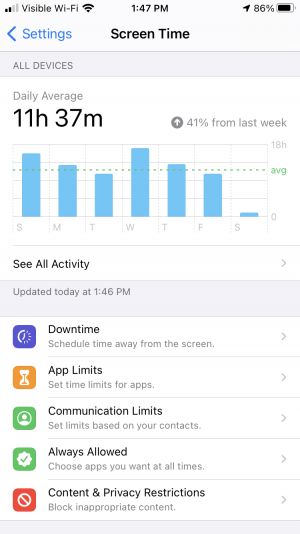Difference between revisions of "Screen time's effect on adolescents mental health"
| Line 1: | Line 1: | ||
Screen time is the aggregate time spent using a device with a digital screen, which can include computers, smartphones, tablets, TV's, and video games. There are five different categories of screen time: social, passive, interactive, educational, and other[ref], and all five categories in excess show negative psychological effects. It is measured in hours per day. | Screen time is the aggregate time spent using a device with a digital screen, which can include computers, smartphones, tablets, TV's, and video games. There are five different categories of screen time: social, passive, interactive, educational, and other[ref], and all five categories in excess show negative psychological effects. It is measured in hours per day. | ||
| − | The effects of screen-time on young users' mental health is an emerging area of research of the 21st century. Adolescents 18-29 comprise the highest proportion of smartphone users, making up 96% of the market share of mobile phone ownership. Studies show that excessive mobile screen time is significantly associated with depressive symptoms. The true extent to which screen-time affects mental health is still being researched, which could inform decisions on regulation. | + | Mental Health is defined by the World Health Organization as a state of well-being whereby individuals recognize their true abilities, are capable of coping with the normal stresses of life, and are capable of productively and joyfully contributing to their communities. The effects of screen-time on young users' mental health is an emerging area of research of the 21st century. Adolescents 18-29 comprise the highest proportion of smartphone users, making up 96% of the market share of mobile phone ownership. Studies show that excessive mobile screen time is significantly associated with depressive symptoms. The true extent to which screen-time affects mental health is still being researched, which could inform decisions on regulation. |
[[File:screen-time phone.png|thumbnail|caption]] | [[File:screen-time phone.png|thumbnail|caption]] | ||
SCREEN TIME and MENTAL HEALTH (giant heading) | SCREEN TIME and MENTAL HEALTH (giant heading) | ||
| − | + | ||
PHYSICAL ACTIVITY | PHYSICAL ACTIVITY | ||
Revision as of 17:01, 27 January 2022
Screen time is the aggregate time spent using a device with a digital screen, which can include computers, smartphones, tablets, TV's, and video games. There are five different categories of screen time: social, passive, interactive, educational, and other[ref], and all five categories in excess show negative psychological effects. It is measured in hours per day. Mental Health is defined by the World Health Organization as a state of well-being whereby individuals recognize their true abilities, are capable of coping with the normal stresses of life, and are capable of productively and joyfully contributing to their communities. The effects of screen-time on young users' mental health is an emerging area of research of the 21st century. Adolescents 18-29 comprise the highest proportion of smartphone users, making up 96% of the market share of mobile phone ownership. Studies show that excessive mobile screen time is significantly associated with depressive symptoms. The true extent to which screen-time affects mental health is still being researched, which could inform decisions on regulation.
SCREEN TIME and MENTAL HEALTH (giant heading)
PHYSICAL ACTIVITY
PSYCHOLOGICAL SYMPTOMS
-depression and anxiety
THEORIES OF USE -compulsory -comparative
5 TYPES
describe w effects
REGULATION -parents? self-regulation?
MODERATION Moderate amounts of electronic screen time are associated with higher mental well-being compared to low or high levels proven good sometimes
